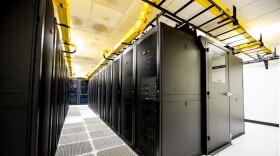There was a hum in the room as the small township office filled up, residents filling the seats, standing along the wall, waiting by the door.
Stan Strzalkowski, chair of the Pavilion Township planning commission, counted the people one-by-one, checking to make sure they weren’t violating the fire code. It was close.
The bell atop the door rang again, as one more person entered.
“So if any more people show up for this,” Strzalkowski announced to the group, “we’re going to have to adjourn and then re-notice it for a bigger space because we’re at limit now for capacity.”
The crowd at the small Pavilion Township office, which sits at the corner of a field and another field, was all there for one reason: to speak out against an AI data center.
And Pavilion Township isn’t alone. Over the past few months, data centers, the massive buildings that house the computers used to drive new artificial intelligence models, have become the hot-button issue in small communities across the state.
“It’s great to see community coming together."Elizabeth Clark
In Howell township, a different planning commission meeting had to be moved to a nearby high school to accommodate the crowd. That meeting stretched on for more than seven hours as residents lined up to speak out against a data center proposal. In Augusta Township, residents organized a petition drive to reverse a zoning change that would allow for a data center. The petition succeeded and residents will vote next year on the zoning change. In Dundee, developers pulled back on a proposal for a data center after strong pushback from local residents.
Many who’ve spoken out worry about the strain new “hyperscale” data centers might put on their towns by consuming vast amounts of electricity and water.
“It’s great to see community coming together,” said Elizabeth Clark, one of the residents who spoke out against the data center zoning amendment change in Pavilion Township.
“We are not all on the same side of a lot of issues. We’re all here on the same side of this one because we all know that we can’t live for seven days without drinkable water," she added.
AI data centers can consume hundreds of thousands, to millions of gallons of water, depending on design, to cool the racks of computers inside. The demand could amount to as much as a small city.
The electricity demands could be even more dramatic.
John Paver, another person who spoke out in Pavilion Township, noted that CMS Energy, the parent company of Consumers, announced plans to supply one gigawatt of electricity to a data center that’s yet to be built.
“This facility, a single facility, will use as much energy as 750,000 homes,” Paver said. “There’s no city in Michigan that is that large.”
A separate rate for data centers?
The power demands of these potential data centers would dwarf even the state’s largest and most power-hungry factories.
The potential for more data centers in Michigan spurred Consumers Energy to file a request with the Michigan Public Service Commission to treat data centers as a separate class of industrial customer, with rules guaranteeing power usage into the future.
Consumers argues the separate rate class will help protect against one of the greatest concerns expressed by local residents opposed to data centers: that data center investments could ultimately drive up electricity costs for everyone in the state.
David W. Isakson, an analyst for the Michigan Public Service Commission, testified over the summer that even a 500 megawatt data center would be 10 times larger than the largest customers Consumers Energy currently serves.
A one gigawatt data center would be twice that size, making it 20 times larger than the current largest customers, and rival the residential demand for a city the size of Detroit.
“So the addition of just one or two of these large customers that we're talking about would eclipse the power demand of the state's largest cities; am I understanding that correctly?” said Lucas Wollenzein, who asked questions on behalf of the Michigan Attorney General’s office in the case.
“Yes, I think that's reasonable,” Isakson responded.
Consumers Energy has asked the state to create new credit requirements for companies that propose data centers in Michigan, and lock in guaranteed purchase agreements lasting at least 15 years, to ensure the data center pays for the power into the future, even if demand for data centers decreases.
The underlying concern is that utility companies will have to make new investments to supply the power to data centers. And if the AI boom fizzles, or a data center operator scales back its operations, the cost of those investments will fall to the utility’s other customers, which include ordinary residential customers.
Not grinding to a halt
“I don’t think development will grind to a halt."Vijay Gadepally, senior staff, MIT Lincoln Laboratory
Michigan is not the only state where local communities have started pushing back against the massive data center buildout.
The group Data Center Watch calculates $64 billion in data center investments were either blocked or delayed nationwide since 2024. Could this pushback ultimately slow down the raging AI buildout?
“I don’t think development will grind to a halt,” said Vijay Gadepally, senior staff at the MIT Lincoln Laboratory. “Theres too many reasons, at least in the near term, for it not to grind to a halt.”
But Gadepally added, the local pushback could have a different effect on the industry. He said in the first wave of data center development for AI, there wasn’t much of an incentive for tech companies to find the most efficient way to train and use AI. It was all about scale and speed.
“Now that there’s some pushback on construction,” Gadepally said, “and either it’s becoming more difficult to get new builds, or it’s becoming more expensive, I think that math is starting to shift again, where people are like, ‘Ok, well, let’s just look at the existing asset and see can we get more out of it?.’”
So, one result of the residents showing up at local meetings is that tech companies could find more ways to make data centers less power hungry. Gadepally works with two startups that aim to improve the efficiency of data centers.
In Michigan’s communities, data center plans may have gone on hold, but they haven’t disappeared. CMS Energy has yet to announce the location of the expected one gigawatt data center, or who will use it.
“We are confident our long-term energy supply plan can responsibly meet the energy needs of our growing state,” a Consumers spokesperson wrote in a statement. “At this time, we’re not able to disclose the counterparty of the agreement or the location of the site but we will keep you updated as the process continues to move forward.”
Company executives say they expect that data center will only be the start, and they told investors they have a “conservative” expectation to supply another eight gigawatts of electricity to future data centers in the coming years, in addition to the one gigawatt data center it announced earlier this year. Meanwhile, DTE Energy disclosed it had been in discussions for up to seven gigawatts of new load from data centers.
Combined, this means the state’s two top utility companies are planning to add up to 16 cities worth of new electricity demand from data centers alone.






